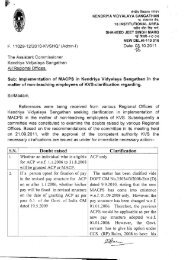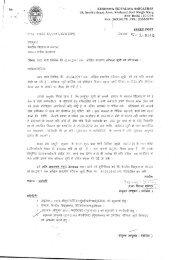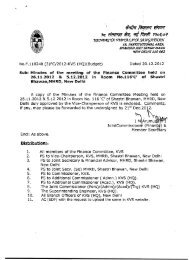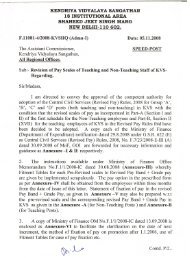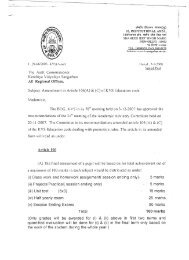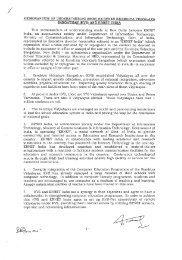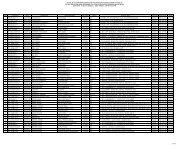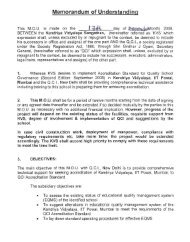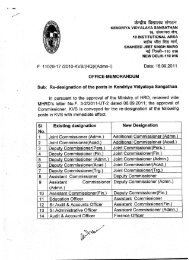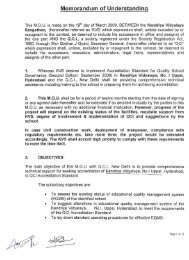Syllabus for written examination for PGT (Biology)
Syllabus for written examination for PGT (Biology)
Syllabus for written examination for PGT (Biology)
You also want an ePaper? Increase the reach of your titles
YUMPU automatically turns print PDFs into web optimized ePapers that Google loves.
Operators (AND/OR/NOT Operators), Logical Operator Precedence, ORDER BY Clause,Sorting in Ascending/Descending Order, Sorting By Column Alias Name, Sorting Onmultiple Columns;Functions: SQL Functions, Types of SQL Function (Single Row/ Multiple Row), Single RowSQL Functions, Character Functions (Case Conversion/ Character Manipulation), CaseConversion Functions [lower (), InitCap (), UPPER ()] Character Manipulation Function[CONCAT (), INSTR (), LENGTH (), TRIM (), SUBSTR (), LPAD () ], Number Functions(ROUND (), TRUNC (), MOD() ), Working with Dates [LAST_DAY(), MONTHS_BETWEEN(),NEXT_DAY(), ADD_MONTHS(), ROUND(), TRUNC() ] Arithmetic Operation on Dates, DateFunctions and their Usage, Data type Conversion Functions, Implicit and ExplicitConversion, TO_CHAR Function with Dates, TO_CHAR Function For Numbers, TO_NUMBERand TO_DATE Functions, NVL Function and its Usage, DECODE Function and its Usage;Grouping Records: Concept of Grouping Records and Nested Grouping, Nested Grouping ofrecords, Group Functions, Types of group functions [MAX (), MIN (), AVG (), SUM (),COUNT ()], using AVG and SUM Functions, Using MIN and MAX Functions, Using theCOUNT Function, using COUNT(*), DISTINCT clause with Count, Group Functions and NullValues, Using NVL Function with Group Functions, Grouping Records: Group By Clause,Grouping By More than One Column, Illegal Queries with Group By Clause, ExcludingGroup Results: Having Clause, Nesting Group Functions.Sub Queries: Concept of Sub-Query, Sub Query to solve a Problem, Guidelines <strong>for</strong> UsingSub Queries, Types of Sub-Queries (Single Row and Multiple Row) and (Single Column andMultiple Column); Single Row Sub-Query and its Execution;Displaying Data From Multiple Tables: Concept of Join, Result of Join, Cartesian Productand Generating Cartesian Production example using Mathematical Set), Types of Joins(EQUL, SELF, NON-EQUI, OUTER (LEFT and RIGHT)), Equi-join, Additional SearchConditions using AND operator, Short Naming Convention <strong>for</strong> Tables (Table Aliases), Non-Equi join and its Implementation, Outer-Join and Its Usage, Self-Join (Joining a table toItself);Manipulating Data of A Table /Relation: Concept of DML (Data Manipulation Language),INSERT Statement, Inserting New Rows, Inserting New Rows, with Null Values, InsertingDate Values, Use OF substitution Variable to Insert Values, Copying Rows From AnotherTable, Update Statement to Change Existing Data of a Table, Updating Rows In A Table,Updating Rows Based on Another Table, Delete statement/ Removing Row/ Rows from aTable, Deleting, Rows Based on condition from another Table; Making Data ManipulationPermanent (COMMIT). Undo Data Manipulation Changes (ROLLBACK)Database Objects: View, Table, Sequence, Index, and Synonyms, DDL (Data DefinitionLanguage), Naming Convention, Creating Views, Creating Synonyms, Simple Views andComplex Views, Retrieving Data From a View, Querying a View, Modifying a view.Including Constraints: Constraints, Concept of using Constraints, Constraint Guidelines,Defining Constraints, NOT NULL, UNIQUE KEY, PRIMARY KEY, FOREIGN KEY, FOREIGN KEYConstraint Keywords, CHECK, Adding a constraint, Dropping a Constraint, DisablingConstraints, Enabling Constraints, Viewing Constraints, Viewing The Columns, Associatedwith Constraints;Creation of a Table/ Relation: CREATE TABLE Statement, Data types, the DEFAULT option,Creating Tables, Referencing Another User’s Tables, Querying the Database Dictionary toview all tables in the Oracle Database, Creating a Table by Using a Sub-Query;Managing Existing Tables and other Database Objects: The ALTER TABLE Statement,Adding a New Column in a Table, Modifying Existing Column, Dropping a Column,Renaming an Object, Truncating a Table, Adding Comments to a Table, Dropping Views,Dropping Synonyms, Dropping Tables; giving permission to other users to work onCreated Tables and Revoking it (GRANT and REVOKE statement).BUSINESS COMPUTINGGeneral concept, User interfaces (front End), Underlying Database (back End), Integrationof User Interface and Database;More application areas of Databases:Inventory control, Financial Accounting, Pay-Accounting System, Invoicing ManagementSystem, Personal Management System/ hard system, Fees Management System, ResultAnalysis System, Admission Management System, Income Tax Management System;Advance Program Development Methodology: System Development Life Cycle, RelationalDatabase Concept, Relational Database, Management System, Data Models (EntityRelationship Model), Entity and Entity Set, Attributes (Single, Composite and Multi-Valued), Relationship (One-to-One, One-to-Many and Many-to-Many), Entity RelationshipModeling Conventions, Communicating with an RDBMS using SQL, Relational DatabaseManagement System, SQL Statements, About programming language in SQL.Data Dictionary, Data Warehousing, Data Mining, Meta Data;Object Modeling: Introduction to object oriented modeling using Unified ModelingLanguage (Concepts only).Client Server Computing: Concept of Client Server Computing.WEB DEVELOPMENT



